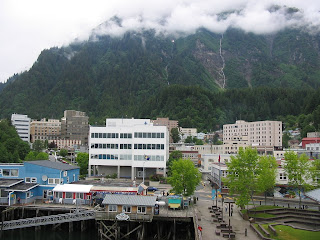We stayed overnight at The Ramada. Not a hotel we were impressed with as there was no porter available and room service doesn't open until 5pm. Luckily we are only here for one night.
Our Cruise ship Windward was looking splendid, as she was dressed overall. We had to go through immigration prior to boarding. We have to do this as our first stop on our cruise will be on American territory.
As with all cruises we have the life boat drill at our boat station before we set sail. It was very hot in our bright orange life jackets. We sailed out of Vancouver harbour to the strains of 'North to Alaska' playing on the ships sound system. We sailed under Lions Gate Bridge in the late afternoon.
The following day we went to a slide show on Alaska given by Bill Tauck, the naturalist aboard. He had some super slides. We are cruising up the inside Passage and the scenery is beautiful, the heavily wooded slopes of the mountains coming right down to the water with waterfalls cascading down into the sea was just as I imagined it.
We sighted a bald eagle away in the distance and a porpoise and some dolphins. Waterfalls falling great distances down to the sea through the trees and patches of snow on the mountains made for a spectacular afternoons viewing. We saw some fishing boats and a logging camp but no villages or habitation at all. The Inside Passage is a long narrow strip of mainland with thousands of islands and fjords.
The next day after breakfast we went to a slide lecture on Juneau. During breakfast a call came over the loud speakers to say that porpoises and hump back whales were off the starboard bow. We collected our cameras and went on deck. There were a lot of hump back whales surrounding the boat, though all at some distance.
We are cruising through squally showers. Alaska is a very wet area; they don't measure their rainfall in inches here but in feet.

We arrived in Juneau at 1.30pm. Juneau has 16 feet of rain on average a year! Juneau is the largest city in the United States (land wise) and is the capital of Alaska. This region was so rich in gold at one time that the mines produced more than $158 million in gold by the early decades of the century. Gold was first found in Gold Creek, which now runs through the centre of town.
Windward is at anchor so we have to take a tender from the boat to the shore. Lifeboats were lowered and a shuttle service was run to and from the boat to the shore all day. We went on the Juneau highlights tour.
Our first stop was the salmon hatchery. It was a good time of year (September) for a visit as the salmon had come back to spawn and we saw some huge salmon in the holding tanks. Inside the visitor centre we saw displays on the life cycle of salmon. There were also displays of animals that prey on the salmon like the bald eagle and the bear.
The highlight of this tour was the Mendenhall Glacier which is just a few miles outside of town. The glacier is a moving river of ice with rugged crevasses and a distinctive blue colour. It is more than 200 feet high, three miles wide and 12 miles long. Fed from an icefield high above Juneau, Mendenhall Glacier is a dynamic flowing force, grinding and scouring everything in its path as it carves its way down to the sea. The blue colour of the glacier is remarkable. Glacial ice has a structure which absorbs or reflects light. As light strikes the ice surface all colours of the spectrum are absorbed except blue, which is reflected back. The glacier is moving forward at a rate of two feet a day.
Mendenhall Glacier
Mendenhall Glacier is one of many 'rivers of ice' in southeast Alaska formed during the Little Ice Age which began about 3,000 years ago. Before 1750, the Mendenhall Glacier was advancing; its face was 2.5 miles down the valley from its present position. Since then, due to slightly warmer temperatures, the glacier began receding. Land buried under the ice for centuries is being exposed.
Our guide told us a great story: Some elderly visitors went into the local pub for a drink. "Barman, we'll have ten whisky's. Make them three parts whisky to one part water".
"Don't you mean one part whisky and three parts water" said the barman.
"No, said the elderly man, at our age we can hold our whisky but we can't hold our water".
We were told that most people here owned a car but the furthest they could drive was 40 miles as that was as far as the road went. They never have to worry about stolen cars here, there is nowhere to take them. Most people own a boat and the only way in and out of Juneau is by boat or float plane, people here learn to fly before they learn to drive a car.

No comments:
Post a Comment